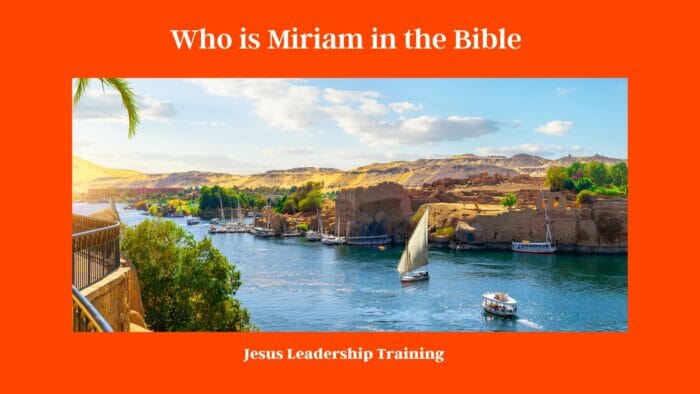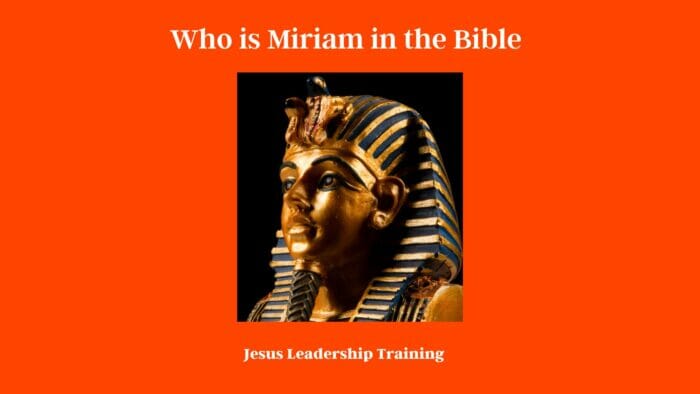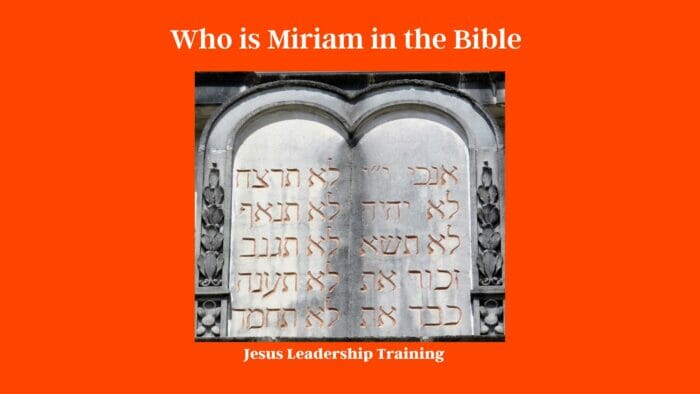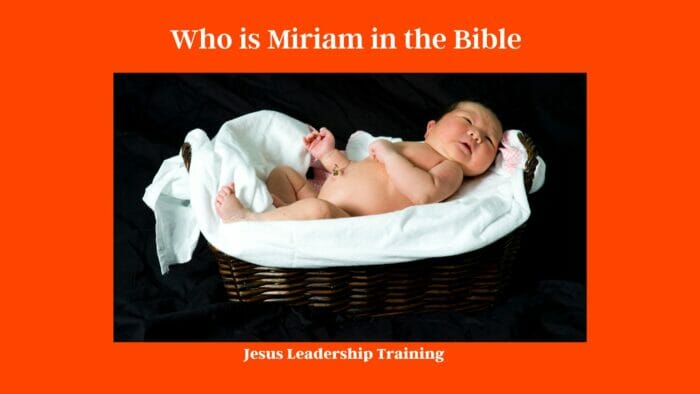Who is Miriam in the Bible – Delving into the labyrinth of history and mythology, we often encounter enigmatic characters whose lives left an indelible mark on humanity’s collective consciousness. One such remarkable personality is Miriam, a pivotal figure in the Bible. But who is Miriam in the Bible? And why is her role of significance in the scriptural narrative? In this article, we will embark on an insightful journey to unravel the intricate tapestry of her life, unveiling the layers of her character and the profound impact of her actions in the biblical narrative.
Table of Contents
Who is Miriam in the Bible
Unveiling the mysteries of Miriam, a significant biblical figure. We delve into her life, roles, and relevance to the biblical narrative to answer “who is Miriam in the Bible?”
Parents,Family, Descendants of Miriam, Moses’ Sister
| Family Relation | Name | Biblical Reference |
|---|---|---|
| Father | Amram | Exodus 6:20 |
| Mother | Jochebed | Exodus 6:20 |
| Brother | Moses | Exodus 2:1-10 |
| Brother | Aaron | Exodus 6:20 |
| Nephews | Nadab, Abihu, Eleazar, Ithamar (Sons of Aaron) | Exodus 6:23 |
| Grand-Nephew | Phinehas (Son of Eleazar) | Exodus 6:25 |
| Grand-Nephew | Abishua (Son of Phinehas) | 1 Chronicles 6:4-5 |
15 Remarkable Women Bible Characters: Their Stories and Impact | Bible | Women
Note: The Bible does not mention a husband or any children of Miriam. Her life was primarily dedicated to assisting her brothers, Moses and Aaron, in their divine mission to lead the Israelites out of Egypt.

Who is Miriam in the Bible?
Miriam, an essential figure in the Old Testament, is best known as the sister of Moses and Aaron. Born to Amram and Jochebed of the tribe of Levi, Miriam’s life is intertwined with the narrative of the Exodus. She is praised as a prophetess and is a leader among the Israelites during their escape from Egypt.
Major events in Miriams Life
| Event | Biblical Reference | Description |
|---|---|---|
| Watching Over Moses in the Nile | Exodus 2:4 | As a young girl, Miriam bravely watched over her baby brother Moses, who had been placed in a basket and set adrift in the Nile river to protect him from Pharaoh’s edict of infanticide. |
| Meeting Pharaoh’s Daughter | Exodus 2:5-9 | Miriam approached Pharaoh’s daughter who found Moses in the Nile and offered to find a Hebrew woman (their mother, Jochebed) to nurse the baby. This act ensured that Moses would have a connection to his Hebrew roots. |
| Song of Triumph After Crossing the Red Sea | Exodus 15:20-21 | Miriam, described as a prophetess, led the women of Israel in a song and dance of celebration with tambourines after the miraculous crossing of the Red Sea and the destruction of Pharaoh’s army. |
| Speaking Against Moses | Numbers 12:1-2 | Miriam and her brother Aaron spoke against Moses because of the Cushite woman he had married. They also questioned his unique relationship with God. |
| Punishment for Rebellion | Numbers 12:10-15 | For her part in the rebellion against Moses, God punished Miriam by turning her skin leprous. After Moses pleaded with God, she was healed but had to stay outside the camp for seven days, effectively delaying the Israelite’s journey. |
| Death and Mourning | Numbers 20:1 | Miriam died in Kadesh during the wandering of the Israelites in the wilderness. The whole community mourned her passing, indicating her important role among the people. |
The Role of Miriam in Moses’ Early Life
Miriam plays a significant role in the early life of Moses. With her quick-thinking and courage, she ensures the survival of her baby brother Moses when the Pharaoh decrees the death of all Hebrew male infants. When Jochebed, their mother, hides Moses in a basket on the river Nile, Miriam watches over the basket. When Pharaoh’s daughter discovers Moses, Miriam cleverly suggests a Hebrew nursemaid – their own mother – ensuring Moses’s safe upbringing while preserving his Hebrew roots.

Events Surrounding Moses Birth, with His Mother Father,Brother and Sister
| Event | Description |
|---|---|
| Pharaoh’s Decree | The Egyptian Pharaoh issued a decree to kill all Hebrew male infants to control the increasing population of Israelites (Exodus 1:16). |
| Moses’ Birth | Moses was born to Amram and Jochebed from the tribe of Levi, during a time when Pharaoh had ordered the death of all Hebrew male babies. Despite the danger, Jochebed and Amram decided to hide their newborn son (Exodus 2:1-2). |
| Moses Hidden | For three months, Jochebed managed to hide baby Moses, defying the Pharaoh’s decree (Exodus 2:2). |
| Placed in a Basket | When hiding Moses became untenable, Jochebed constructed a waterproof basket and placed Moses in it. She then set the basket adrift in the Nile River, trusting God for his protection (Exodus 2:3). |
| Miriam’s Watch | Miriam, Moses’ older sister, watched over the basket from a distance to see what would happen to her baby brother (Exodus 2:4). |
| Found by Pharaoh’s Daughter | Pharaoh’s daughter found Moses in the basket while she was bathing in the Nile. She felt compassion for the child and decided to raise him as her own (Exodus 2:5-6). |
| Miriam’s Intervention | Miriam came forward and suggested a Hebrew nurse for the baby. When Pharaoh’s daughter agreed, Miriam brought Jochebed, their mother. In this way, Moses was nursed by his biological mother and was raised in his early years within his Hebrew family (Exodus 2:7-9). |
| Moses Grows Up | Moses was eventually returned to Pharaoh’s daughter and grew up in the Egyptian royal household, receiving an Egyptian education. However, his early years with his Hebrew family ensured that he knew about his true heritage (Exodus 2:10). |
| Aaron | Aaron, Moses’ older brother, doesn’t directly participate in these events. However, he later becomes an essential partner in Moses’ mission to free the Israelites from Egypt (Exodus 4:14-16). |

Miriam as Prophetess (Bible)
Miriam is recognized as a prophetess in the Bible, one of the seven major female prophetesses in the Jewish tradition. After the parting of the Red Sea, she leads the women in song and dance, praising God for their deliverance from Egypt. This moment reflects her leadership and her strong faith.
While Miriam is described as a prophetess in Exodus 15:20, there are no specific recorded prophecies attributed to her in the Bible. However, her role as a prophetess is signified in her leadership and influence among the Israelites, particularly during the Exodus journey. Her song of triumph after the crossing of the Red Sea (Exodus 15:20-21) is considered an example of her prophetic role as it celebrates God’s deliverance and anticipates future victories for the Israelites.
| Instance | Biblical Reference | Description |
|---|---|---|
| Prophetic Song of Deliverance | Exodus 15:20-21 | After the Israelites crossed the Red Sea, Miriam led them in a song of victory, praising God for His deliverance and drowning of the Egyptian army. This song, also known as the “Song of Miriam,” is a form of prophetic utterance as it gives thanks to God and predicts His ongoing support and victory for the Israelites. |
Her status as a prophetess is further supported by Jewish tradition and the Talmud, where it’s suggested that Miriam had prophesied her brother Moses’s birth and the role he would play in the deliverance of the Israelites. However, these accounts are not explicitly found in the biblical text.
Miriam’s Role in the Exodus (Moses’s Life)
The story of the Exodus is incomplete without the mention of Miriam. Her leadership, alongside her brothers Moses and Aaron, is pivotal to the Israelites’ journey.
Miriam’s Song of Deliverance
Following the miraculous crossing of the Red Sea, Miriam, referred to as the “prophetess”, takes a timbrel in her hand, leading the women in a song of triumph. This song, often known as the Song of Miriam, is a vital part of Jewish liturgy.
The Leadership Triad: Moses, Aaron, and Miriam (God)
Miriam, along with her brothers Moses and Aaron, forms a powerful leadership triad. While Moses is recognized as the leader who communicates directly with God, Aaron acts as the high priest, and Miriam emerges as a spiritual leader, particularly among the women.
The Controversy of Miriam: Conflict and Punishment
Despite her significant role in the Exodus, Miriam’s story also includes a controversial episode of rebellion, leading to her punishment.
- Exodus 2:1-10: Miriam and Aaron, the siblings of Moses, are born to Amram and Jochebed. In order to save Moses from Pharaoh’s edict to kill all the male Hebrew children, Jochebed places Moses in a basket in the Nile River. Miriam watches from a distance to make sure he is safe.
- Exodus 2:11-15: Miriam approaches Pharaoh’s daughter, who finds Moses and takes him in as her own son. Miriam then suggests to Pharaoh’s daughter that she can get a Hebrew woman to nurse the child.
- Exodus 2:16-22: Jochebed is hired as the nurse for Moses and Miriam watches over them. After Moses has grown up, Miriam helps Moses reunite with his family.
- Exodus 4:14-17: Miriam and Aaron are not pleased with Moses’s marriage to a Cushite woman. Miriam is punished for her criticism and temporarily becomes leprous.
- Exodus 15:20-21: After the Israelites escape from Egypt, Miriam leads a celebration and sings praises to God.
- Numbers 12:1-2: Miriam and Aaron criticize Moses for marrying a Cushite woman.
- Numbers 12:10-15: Miriam is punished for her criticism of Moses and becomes leprous. Moses prays to God to heal her and she is eventually healed.
- Numbers 20:1-2: Miriam passes away and is buried in Kadesh.
The Rebellion Against Moses
In a complex episode, Miriam and Aaron challenge Moses’s exclusive claim to prophecy. They criticize him for marrying a Cushite woman, a criticism that may conceal deeper tensions about leadership roles.
List all the Rebellions against Moses
| Rebellion | Description |
|---|---|
| Israelites at the Red Sea | After Pharaoh released the Israelites from Egypt, he changed his mind and pursued them. The Israelites, seeing the approaching Egyptian army and trapped by the Red Sea, blamed Moses for bringing them out of Egypt to die in the wilderness (Exodus 14:11-12). |
| Grumbling for Food | The Israelites grumbled against Moses and Aaron due to a lack of food in the wilderness. In response, God provided manna and quail (Exodus 16:2-4). |
| Complaints for Water | The Israelites quarreled with Moses because of a lack of water at Rephidim, testing God in their unbelief. God commanded Moses to strike a rock at Horeb, from which water flowed out (Exodus 17:1-7). |
| Golden Calf Incident | While Moses was on Mount Sinai receiving the law, the Israelites, led by Aaron, made a golden calf and worshiped it. God’s judgment fell on them for this blatant rebellion (Exodus 32:1-35). |
| Korah’s Rebellion | Korah, along with Dathan, Abiram, and 250 leaders of Israel, rebelled against Moses and Aaron’s authority. God’s judgment was swift as the ground opened up and swallowed Korah, Dathan, and Abiram and their households. Fire from the LORD consumed the 250 leaders offering incense (Numbers 16:1-35). |
| Complaints After Korah | The next day after Korah’s rebellion, the Israelites grumbled against Moses and Aaron, blaming them for the deaths. God sent a plague as judgment, but it was stopped by Aaron offering incense and making atonement for the people (Numbers 16:41-50). |
| Rebellion at Meribah | The Israelites once again quarreled with Moses due to lack of water at Meribah. However, this time Moses and Aaron did not uphold God’s holiness in the eyes of the Israelites. As a result, they were not allowed to bring the Israelites into the Promised Land (Numbers 20:2-13). |
| Grumbling Against God’s Judgments | After a failed attempt to enter Canaan without God’s blessing, the Israelites grumbled against Moses and wished they had died in Egypt or the wilderness. In response, God made them wander in the wilderness for 40 years (Numbers 14:2-35). |
The Leprosy Punishment
For her rebellion, Miriam is punished with leprosy by God. After Aaron’s plea, Moses prays for her healing, and she is healed after seven days. Despite this punishment, Miriam’s place as a cherished prophetess and leader remains undiminished in the biblical narrative.
Understanding Leprosy: A Historical Perspective
Leprosy, also known as Hansen’s disease, is one of the oldest diseases known to humankind. Its mention in ancient texts such as the Bible and accounts by Greek philosopher Hippocrates bear testimony to its historical prevalence.
Despite its long-standing existence, the causal organism – Mycobacterium leprae, was only identified in 1873 by Gerhard Armauer Hansen. Leprosy primarily affects the skin and peripheral nerves, leading to skin lesions, muscle weakness, and sensory loss. While it may appear daunting, advancements in medical science have paved the way for effective treatment and management of this disease.
Leprosy in the Modern World: Epidemiology and Transmission
As of today, leprosy is a rare disease in the United States and most other parts of the world, thanks to concerted global health efforts. According to the World Health Organization, less than 200,000 cases exist globally, most of them concentrated in Brazil, India, and Indonesia. Contrary to popular belief, leprosy is not highly contagious.
It is believed to spread via droplets from the nose and mouth of untreated, prolonged cases during close and frequent contact. However, it’s important to note that over 95% of people have natural immunity to the disease.
The Light at the End of the Tunnel: Treatment and Cure for Leprosy
The development of multi-drug therapy (MDT) in the 1980s marked a significant milestone in the battle against leprosy. Comprising three antibiotics—dapsone, rifampicin, and clofazimine, this treatment approach has proven to be highly effective in curing the disease, leading to a massive decline in global prevalence rates.
MDT is provided free of charge to all patients worldwide by the World Health Organization, heralding hope for the affected. Moreover, early detection and treatment can prevent disability due to leprosy, further underscoring the importance of healthcare accessibility and public awareness about this disease.
Miriam’s Death and Legacy
The Death of Miriam
Miriam’s death is recorded in the Book of Numbers, where she dies and is buried in Kadesh. Following her death, the community is left without a water source, a scenario leading to the episode of Moses striking the rock.
Legacy of Miriam: The Celebrated Prophetess (Woman)
Despite the trials and controversies, Miriam’s legacy as a prophetess and a leader remains influential. The “Well of Miriam”, associated with the miraculous water supply during the Israelites’ wanderings, is a testament to her lasting legacy.
Meaning of Miriam
Etymology of the Biblical Name Miriam
The name Miriam has a rich and ancient history. Its etymology can be traced back to the Hebrew Bible, where it is first seen in the Book of Exodus. The origin of the name Miriam is derived from the Hebrew, Greek, and Aramaic languages.
Origin of Miriam
In Hebrew, the name Miriam is derived from the word mariam, which means “bitter.” This reflects the experience of the Biblical Miriam, sister of Moses and Aaron, who was exiled from Egypt due to her role in the enslavement of the Israelites. The name also carries a strong sense of bitterness and sorrow associated with the experience of slavery.
Hebrew Meaning of Miriam
In Hebrew, the name Miriam is derived from the word mariam, which means “bitter.” This is likely a reference to the experience of the Biblical Miriam, sister of Moses and Aaron, who was exiled from Egypt due to her role in the enslavement of the Israelites. The name also carries a strong sense of bitterness and sorrow associated with the experience of slavery.
Greek Meaning of Miriam
In Greek, the name Miriam is derived from the word μαριαμ, which is a variant of the Hebrew word mariam. This is likely a reference to the experience of the Biblical Miriam, sister of Moses and Aaron, who was exiled from Egypt due to her role in the enslavement of the Israelites. The name also carries a strong sense of bitterness and sorrow associated with the experience of slavery.
Aramaic Meaning of Miriam
In Aramaic, the name Miriam is derived from the word מרים, which is a variant of the Hebrew word mariam. This is likely a reference to the experience of the Biblical Miriam, sister of Moses and Aaron, who was exiled from Egypt due to her role in the enslavement of the Israelites. The name also carries a strong sense of bitterness and sorrow associated with the experience of slavery.
Overall, the name Miriam carries strong associations with the experience of slavery and the bitter emotions associated with it. It is an important reminder of the strength and resilience of the Israelites and their experience of oppression. Today, the name still carries a sense of strength and courage, making it a popular choice for many parents.
Names that come from the Biblical name of Miriam
Certainly, the biblical name “Miriam” is thought to be of Hebrew origin and carries a few different interpretations, such as “bitter,” “rebellious,” and “strong waters.” Despite the meaning, it’s been the basis for numerous variations and adaptations in many cultures. Here’s a list of some names derived from or related to “Miriam”:
| Derived Names | Origin |
|---|---|
| Mary | English |
| Maria | Spanish, Italian, Portuguese, and others |
| Marie | French |
| Mariam | Arabic |
| Mirjam | Dutch, Finnish |
| Mireille | French |
| Mireia | Catalan |
| Miren | Basque |
| Marianne | French, English |
| Maureen | Irish |
| Moira | Scottish, Irish |
| Myriam | French, Dutch |
| Marika | Hungarian |
| Meera | Indian |
| Mariah | English |
Please note that while these names are connected to the original name “Miriam,” the meanings can differ slightly in different cultures and languages.
Frequently Asked Questions
- Why is Miriam important in the Bible?
Miriam is important in the Bible as she plays a vital role in the Exodus, serving as a prophetess and a leader. Her actions, including saving her brother Moses and leading the women in song and dance, exemplify her faith and courage. - What does the name Miriam mean?
The name Miriam is of Hebrew origin and is believed to mean ‘rebellious’ or ‘wished-for child.’ It’s the original version of the name Mary. - How is Miriam depicted in the Bible?
Miriam is depicted as a prophetess, a leader, and a sister to Moses and Aaron. She’s a complex character who showcases bravery, leadership, but also rebellion. - What was Miriam’s punishment and why was she punished?
Miriam was punished with leprosy by God for rebelling against Moses’s leadership. After seven days, she was healed. - What can we learn from Miriam’s life?
Miriam’s life offers lessons on faith, leadership, the courage of conviction, but also the consequences of rebellion against God-given authority. - Who were Miriam’s family?
Miriam was the daughter of Amram and Jochebed, and the sister of Moses and Aaron, belonging to the tribe of Levi.
Lessons we can Learn from Miriam
| Lesson | Explanation |
|---|---|
| Leadership | Miriam was a leader among the Israelites, particularly the women. Her song of deliverance after crossing the Red Sea (Exodus 15:20-21) showcases her leadership in celebrating and remembering God’s faithfulness. |
| Courage | Miriam exhibited courage from a young age. As a child, she bravely watched over her baby brother Moses when he was placed in a basket and set adrift on the Nile. She even spoke to Pharaoh’s daughter and arranged for Moses’ own mother to nurse him (Exodus 2:4-8). |
| Trust in God | Miriam’s song after crossing the Red Sea displays her deep faith and trust in God’s power and protection (Exodus 15:20-21). |
| Consequence of Rebellion | In Numbers 12, Miriam and Aaron spoke against Moses, questioning his sole leadership. God punished Miriam with leprosy for a week, teaching us about the consequences of rebellion and the importance of respecting God-appointed leaders. |
| Repentance and Restoration | After Miriam’s rebellion, she was struck with leprosy. But when Aaron pleaded with Moses, Moses prayed for her healing. This event shows us that repentance can lead to restoration (Numbers 12:10-15). |
| Importance of Praise and Worship | Miriam’s spontaneous response of praise after the crossing of the Red Sea reminds us of the importance of praising God in all circumstances, especially during deliverance and victory (Exodus 15:20-21). |
Final Thoughts – Who is Miriam in the Bible
Tracing the footprints of Miriam in the sands of biblical narrative leads us through a riveting tale of faith, courage, leadership, and rebellion. Her life is as complex as it is inspirational, and through her story, we get a glimpse of a woman who played an instrumental role in shaping the destiny of a nation. As we ponder over “who is Miriam in the Bible”, we find a woman whose legacy continues to echo through the ages, reminding us of the indomitable spirit of human faith and resilience.





